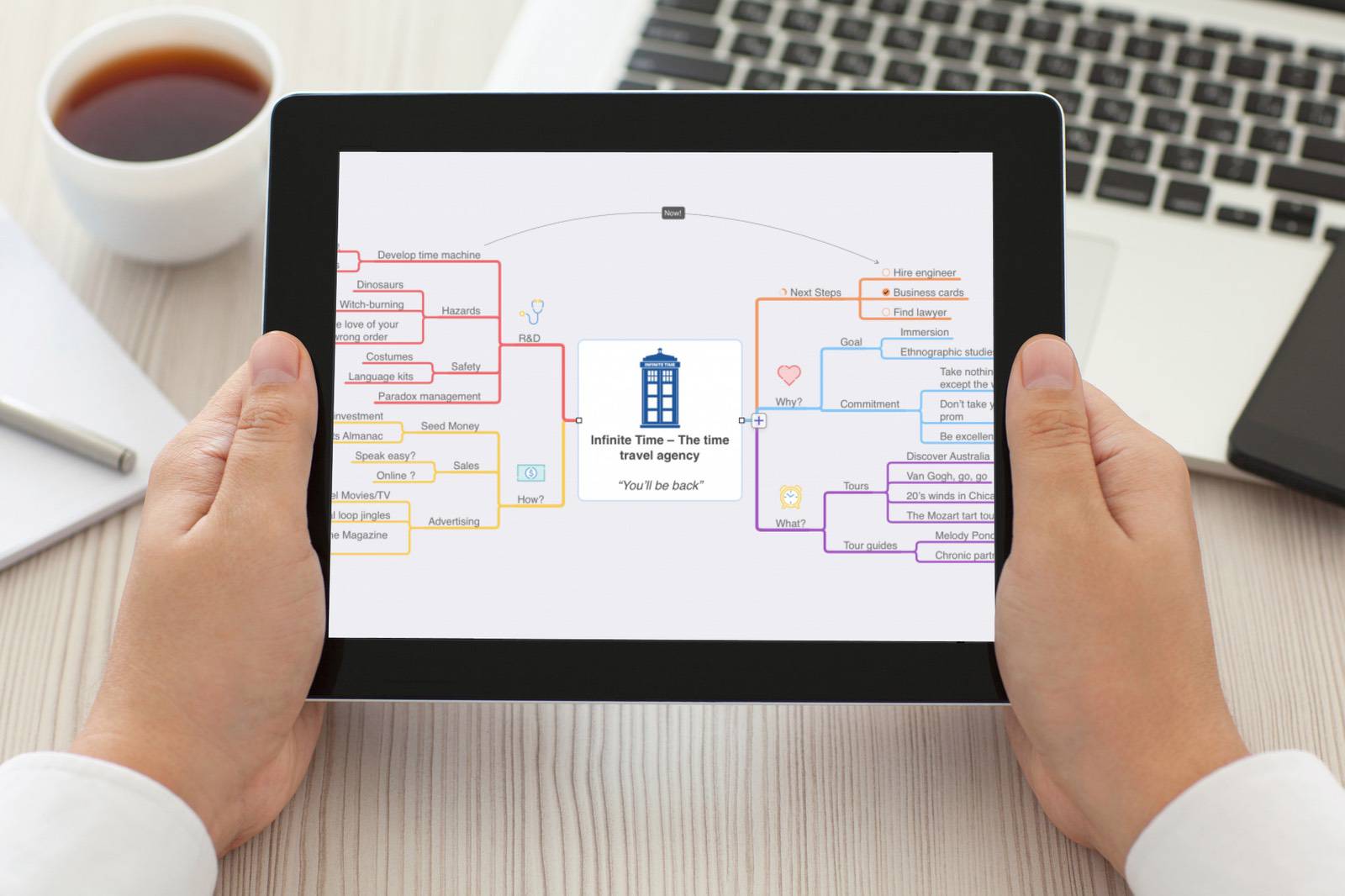Great ideas don't just come from great minds. Anyone can learn to be creative and fuel unique solutions using the right tools. One of those resources is mind mapping software designed to help you achieve greatness through visual brainstorming.
What is Mind Mapping Software?
Mind mapping software is applications that use a visual interface to brainstorm ideas without any particular order or structure. It starts with a central idea and branches out into thoughts, tasks, words, concepts, ideas, and items. It can be as unique as the person creating it.
There is no format, no hierarchy, and it works on a non-linear construct to freeform connections the way a typical brain works. Because it works the way your mind does, it can help with memory and analysis and show you connections that you would have otherwise missed.
What Makes a Great Mind Mapping Software?
When shopping for the best mind mapping software, something to consider is what makes a program of this type great?
- Simplicity - First of all, you want it to be easy to use. If you have to wade through menus and tutorials to get started and then can't find the right tools, it will not work well.
- Unlimited Space - When crafting a mind map, you need unlimited space. Your canvas should be as large as you need it to be and it should grow with your creation.
- Flexibility - Other necessary features are the ability to attach files (images, audio, other types) and import and export files using various formats.
- Share and Print - You also need to be able to share and print your files. Collaboration tools are a must for some users.
- Support - How easily can you get support when you run into trouble?
The Best Mind Mapping Software
Below is our list of the best mind mapping software, including some free mind mapping software. XMind stands out as the best overall mind mapping solution, but there are other contenders out there that may be better suited for your needs.
1. XMind
XMind is the first in our lineup of the best mind map software. It is powerful, flexible, and easy to use. Users love the navigation and layout options. Themes give the mind mapper the ability to customize it to their own taste.

Another great feature is the Tree Table feature putting all your creative ideas into a nice spreadsheet format to review. It gives you another way to look at your ideas without altering the creative process. You can also insert pictures, icons, and even audio clips to make your mind map complete.
The tool has plenty of tools to draw lines, add shapes, apply color and create visual connections in a snap. The interface is clean and easy to understand, which is not the case with all mind mapping software.
They do have a free version, but it is limited compared to the premium version. Another nice feature is the ability to import, export, and share in various formats. You can even password protect your most sensitive mind maps.
The program is packed with features; however, some users complain about slowdowns with large maps and that the mobile app is not as good as the desktop version. The app costs $60/year or $40 for six months. You can use the software on 5 devices for that price.
✅ PROS:
- Standalone product is excellent.
- Multiple export formats.
- Integration with Evernote.
- Easy to use for beginners.
- Various layout options.
- Shortcuts to make things easy.
- Print easily.
- Password protection built in.
- Use on 5 devices simultaneously.
- High ratings from users.
⛔️ CONS:
- Mobile version needs work.
- Free version is very limited.
- Slows down with large mind maps.
- Requires an account to use.
2. MindMup
The best free mind map software is MindMup allowing you to create a quick mind map without even setting up an account. However, free files get deleted automatically after six months. If you want to pay $2.99/month, you can take full advantage of all the premium features.

MindMup has some automation features that make it perfect for waterfall project management. With each level that you create, the font automatically decreases in size. People love the distraction-free interface. The software also integrates with Google Apps making exporting and sharing that much easier. MindMup runs in your browser, so nothing to install. It is lightweight, fast, and efficient.
Although MindMup has a lot of features and a simple interface, it feels less sophisticated than other programs. If you need a quick, free solution, however, it's a great option. The personal package is $25/year; they also have team options ranging from $50-$150/year.
✅ PROS:
- Free version works well without an account.
- Simple, easy-to-use interface.
- Post to social media seamlessly.
- Add files easily.
- Automatic font size decrease with every level.
- Storyboards to write a project plan.
- Best project management software for mind mapping.
⛔️ CONS:
- Feels less sophisticated than other programs.
3. Miro
Miro calls itself an online collaborative whiteboard system for teams. Miro is not strictly a mind mapping software tool. It also works for diagrams, flowcharts, and presentations. Its strong point is collaboration.

It was designed to use with teams that want to work together on projects and provide ample feedback as things progress. For professional workgroups, Miro is the tool to choose. It has fluid collaboration tools built-in, allowing multiple users to edit in real-time and share their screens, comment, and more. You can even hold meetings via video or audio within the platform.
You can also import media on the fly from other services and use a whole host of very helpful templates to get you started. Miro is a powerhouse when it comes to built-in resources.
Miro offers a free account to try the service then you can upgrade for all the extra features. Overall, Miro is an excellent tool for teams, but it can get a bit pricey especially if your group is large.
✅ PROS:
- Robust collaboration tools (in real-time).
- Video/audio calls built in.
- Screen sharing.
- Import media from other apps like Vimeo or Asana.
- Free account.
- Dozens of helpful templates.
- Web browser version plus mobile apps.
- Easy navigation.
- Unlimited canvas area.
- Feature-rich.
⛔️ CONS:
- Free version is limited.
- Costly, especially for larger teams.
4. Coggle
Coggle is another popular mind map platform. It is 100% cloud-based, so nothing to install. Their tagline is "a clear way to share complex information."

The interface is very simple and easy to understand, even if you are creating your very first mind map. The visual graphics are elegant and have a high-end feel. The app is very intuitive, where you just click a plus button to get started. You do need to set up an account to use Coggle.
The system also has templates to get you started. The cache of design tools works excellent for flowcharts. You aren't limited by space or cloud storage either. You can even have multiple starting points and go from there.
Coggle offers a free plan, an Awesome plan for $5/month, and a full-featured Organization plan for $8/month per user. There is nothing to dislike about Coggle. It is a great program with fantastic features at a fair price.
✅ PROS:
- Elegant interface with fantastic graphics.
- Super easy to use.
- Real-time collaboration tools baked in.
- Dozens of useful templates.
- Multiple starting points.
- Unlimited image uploads.
- Import and export file type options.
⛔️ CONS:
- Requires an account.
- Limited free plan.
5. MindMeister
Another powerhouse mind mapping tool is MindMeister. It starts with a clean, modern interface that is really enjoyable to use.

The company boasts of 20 million users! It also gets great reviews from users in the App Store. The mind maps you create are very colorful and visually stunning. You can easily put together a presentation using the built-in features and helpful templates. MindMeister also has robust collaboration tools to share ideas with colleagues or friends. It works very well for project management teams.
Some unique features of this software are, notes, meeting management tools, and a history view so you can go back and review changes.
MindMeister is very flexible, and each user can customize the design to suit their needs. They offer a limited free plan and then a personal plan for $4.99/month. For teams and professionals, they have an $8.25 plan and a $12.49 plan for businesses.
⛔️ CONS:
- Commenting.
- Powerful collaborative features.
- Great templates.
- Clean, modern interface.
- Excellent mobile apps.
- Customizable interface.
- Task management tools.
⛔️ CONS:
- Limited support options.
- A bit on the pricey side for teams.
- Limited free plan (3 mind maps).
Conclusion
If you want our opinion, you cannot go wrong with XMind. Users and reviewers love the product inside and out. Another favorite of ours is Coggle, with its elegant interface and powerful, behind-the-scenes features. For teams, MindMeister is an excellent product for seamless collaboration.
However, the choice is yours. So, when searching for just the right tool to get your mind maps down on paper, consult the list above and review the features and prices best for you.

